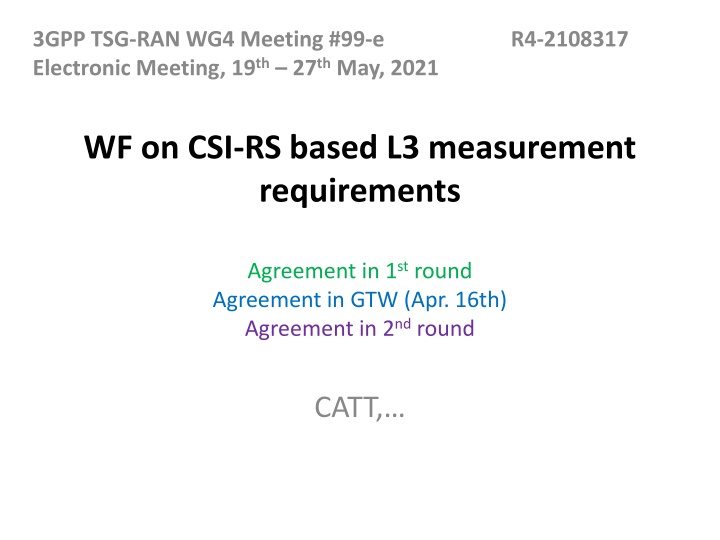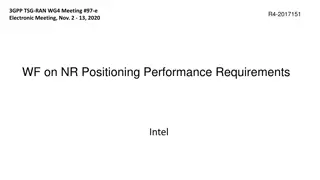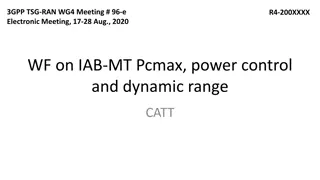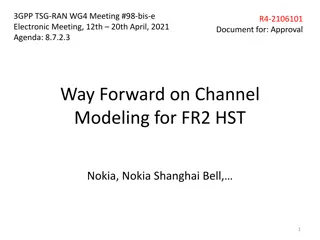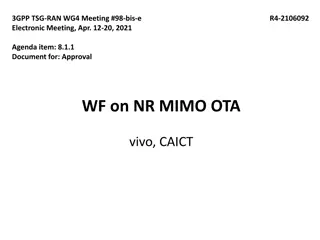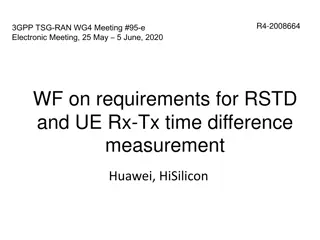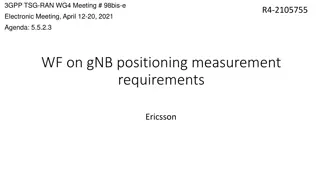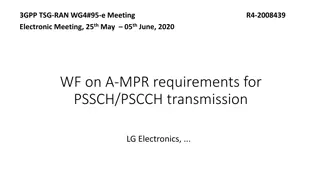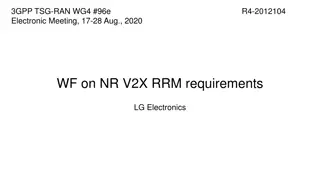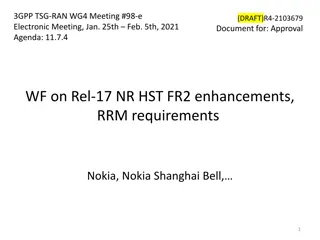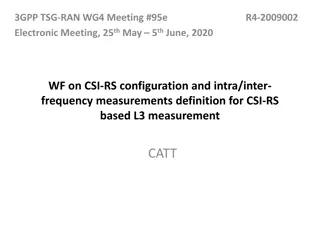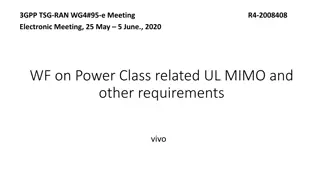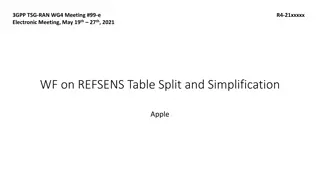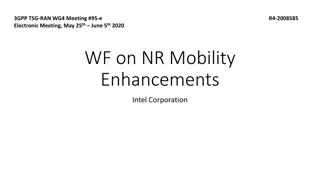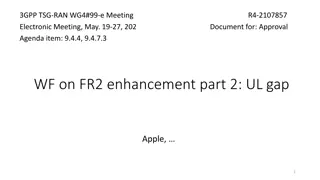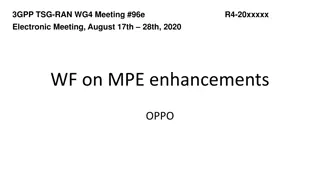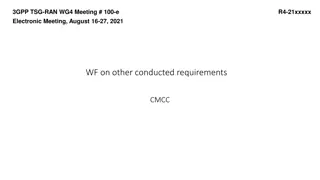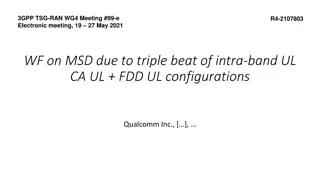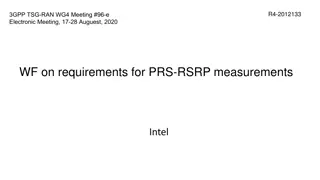CSI-RS Measurement Requirements and UE Behavior: 3GPP TSG-RAN-WG4 Meeting #99-e
The electronic meeting at the 99th session of 3GPP TSG-RAN-WG4 discussed CSI-RS configuration and L3 measurement requirements. Options were outlined for time domain restrictions, UE behavior in case of timing offset exceedance, and time validity of detected associated SSB. Various companies and their approaches were detailed, including Nokia, Intel, Apple, Huawei, and more. Detailed specifications for different scenarios were provided, ensuring proper network configurations and UE measurements as per Rel-16 standards.
Download Presentation

Please find below an Image/Link to download the presentation.
The content on the website is provided AS IS for your information and personal use only. It may not be sold, licensed, or shared on other websites without obtaining consent from the author.If you encounter any issues during the download, it is possible that the publisher has removed the file from their server.
You are allowed to download the files provided on this website for personal or commercial use, subject to the condition that they are used lawfully. All files are the property of their respective owners.
The content on the website is provided AS IS for your information and personal use only. It may not be sold, licensed, or shared on other websites without obtaining consent from the author.
E N D
Presentation Transcript
3GPP TSG-RAN WG4 Meeting #99-e Electronic Meeting, 19th 27thMay, 2021 R4-2108317 WF on CSI-RS based L3 measurement requirements Agreement in 1stround Agreement in GTW (Apr. 16th) Agreement in 2ndround CATT,
Sub-topic 1-1 Time domain restriction for CSI-RS configuration Option 1: (CATT, OPPO, Xiaomi, Qualcomm, MTK, Intel, Apple, vivo) Rel-16 L3 CSI-RS requirements are defined under assumption that all CSI-RS resources in the same MO are configured in the same 5ms window Note: It is up to the network whether to configure all CSI-RS in the 5ms window and if CSI-RS resources are configured outside then UE may not measure it and the requirements do not apply. Option 2: (Huawei, CATT, Nokia, Qualcomm, Intel, Apple) For inter-frequency measurements, Rel-16 L3 CSI-RS requirements are defined under assumption that all CSI-RS resources in the same MO are configured in the same 5ms window For intra-frequency measurements: Rel-16 L3 CSI-RS requirements are defined under assumption that CSI-RS resources in the same MO can be configured in up to two separated 5ms windows during one CSI-RS resource period The overlapping status with MG is same for the two windows. The minimum periodicity of the configured CSI-RS resources is 20ms. Measurement requirements are not impacted by separated 5ms windows.
Sub-topic 1-2 UE behavior when the timing offset exceeds the threshold with single FFT assumption Option 1: (Nokia, Intel, Apple) For intra-frequency measurement, the UE is not required to measure the configured CSI-RS resources of a neighbour cell if the symbol level misalignment between serving and the corresponding neighbour cell exceeds the threshold. For inter-frequency measurement, UE can pick up any cell as the reference cell per frequency layer. UE is not required to measure the configured CSI-RS resources of a neighbour cell if the symbol level misalignment between the reference cell and the corresponding neighbour cell belonging to the same frequency layer exceeds the threshold. Option 2: (Huawei, CATT, OPPO, Xiaomi, Qualcomm, MTK, Intel, vivo) No spec updates are needed.
Sub-topic 1-3 Time validity of the detected associatedSSB Option 1: (Huawei, CATT, OPPO, Qualcomm, vivo) The associatedSSB is detected if it has been meeting the relevant cell identification requirement during the last 5 seconds. Option 2: (Huawei, Qualcomm, Apple, vivo) The timing information of CSI-RS resources for L3 measurement can be assumed as known if the associatedSSB has been detectable during the last 5 seconds. Option 3: (Huawei, Nokia, MTK) Adding the time validity of detected associatedSSB and SFN information in 9.10.2.5 section: If the associatedSSB which has been detectable at least for the time period Tidentify_intra_with_index defined in clause 9.2.5.1 becomes undetectable for a period 5 seconds and then the cell becomes detectable again with the same spatial reception parameter provided the timing to that cell has not changed more than 3200 Tc, PSS/SSS detection time of associatedSSB and time period used to acquire the SFN information are equal to 0.
Sub-topic 2-1 Valid condition of CSI-RS configuration in the specification Agreements: The accuracy requirements in Table 10.1.2.3.2-1 are valid under the following conditions: The bandwidth of CSI-RS is 48 PRBs and the density is 3. The performance with larger bandwidth of CSI-RS is equal to or better than the accuracy requirements in Table 10.1.2.3.2-1.
Sub-topic 2-2 CSI-SINR measurement accuracy requirements Agreements in RAN4#98bis-e meeting: Specify CSI-SINR accuracy requirement based on the following conditions on timing offset between the reference measurement timing and the target CSI-RS (T ) and Es/Iot side condition(s) Side condition #1: |T | CP/2 and Es/Iot 15 dB Side condition #2 |T | CP and Es/Iot [6] dB Note: the value of Es/Iot can be revisited based on additional simulation results in next meeting. No dedicated test cases will be introduced for side condition #2 Agreements in this meeting Es/Iot upper bound for side condition #2 of CSI-SINR accuracy requirements is 4dB.
